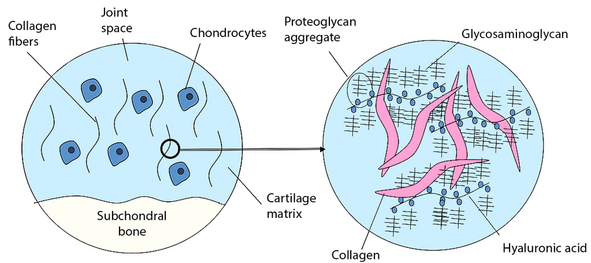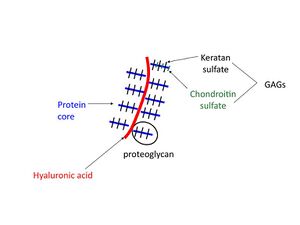Proteoglycans: Difference between revisions
No edit summary |
No edit summary |
||
| Line 6: | Line 6: | ||
== Introduction == | == Introduction == | ||
[[File:Glycosaminoglycans.png|thumb|591x591px|GAGs, proteoglycan, glycoproteins, cartilage matrix]] | [[File:Glycosaminoglycans.png|thumb|591x591px|GAGs, proteoglycan, glycoproteins, cartilage matrix]] | ||
Proteoglycan are of a class of glycoproteins of high molecular weight that are found especially in the extracellular matrix of connective tissue (the fibrous tissue that gives support to the body structure). <ref>Merriam Webster Proteoglcan Available:https://www.merriam-webster.com/dictionary/proteoglycan (accessed 18.6.2022)</ref> Proteoglycans make up a major part of the extracellular matrix, the | Proteoglycan are of a class of glycoproteins of high molecular weight that are found especially in the extracellular matrix of connective tissue (the fibrous tissue that gives support to the body structure). <ref>Merriam Webster Proteoglcan Available:https://www.merriam-webster.com/dictionary/proteoglycan (accessed 18.6.2022)</ref> Proteoglycans make up a major part of the extracellular matrix, acting as fillers between the spaces that occur between cells. Different from other body tissues, the extracellular matrix is the most significant part of connective tissue.<ref name=":0">All the science Proteoglycans Available: https://www.allthescience.org/what-are-proteoglycans.htm (accessed 18.6.2022)</ref> | ||
== Sub Heading 2 == | == Sub Heading 2 == | ||
[[File:Glycosaminoglycans2.jpeg|thumb|GAGs, proteoglycan, glycoprotein, keratan sulfate, cartilage matrix]] | |||
Ways to classify | |||
# GAGs: Proteoglycans can be classified according to the glycosaminoglycans (GAGs) attached to them. Proteoglycans are proteins with chains of polysaccharides attached. The exact type of polysaccharides connected to proteoglycans are called glycosaminoglycans (GAGs), the types of GAGs being chondroitin sulfate, dermatan sulfate, heparin sulfate, heparan sulfate, or keratan sulfate. | |||
# Size: Large molecules eg aggrecan, an important part of cartilage, and versican, which is found in the blood vessels and skin. Small molecules present in various connective tissues include decorin, biglycan, fibromodulin, and lumican<ref name=":0" />. | |||
== Synthesis == | |||
Proteoglycans are synthesized in the rough endoplasmic reticulum, then reshaped in the golgi body, and are ultimately transported to the extracellular matrix by vesicles.<ref name=":1">Lamoureux F, Baud'huin M, Duplomb L, Heymann D, Rédini F. Proteoglycans: key partners in bone cell biology. Bioessays. 2007 Aug;29(8):758-71. Avcailable:https://pubmed.ncbi.nlm.nih.gov/17621645/ (accessed 18.6.2022)</ref> | |||
== Diverse Functions == | |||
Proteoglycans have an important role in the physiology and biomechanical function of tendons, ligaments and cardiovascular system via their involvement in regulation of assembly and maintenance of extracellular matrix, and as they participate in cell proliferation through their interactions with growth factors<ref>Halper J. Proteoglycans and diseases of soft tissues. Progress in heritable soft connective tissue diseases. 2014:49-58.Available:https://pubmed.ncbi.nlm.nih.gov/24443020/ (accessed 18.6.2022)</ref>. Eg | |||
* Cartilage contains a variety of proteoglycans, being essential for its normal function. These include aggrecan,decorin, biglycan, fibromodulin and lumican. Each proteoglycan serves several functions that are determinedby both its core protein and its glycosaminoglycan chains<ref>Carney SL, Muir H. The structure and function of cartilage proteoglycans. Physiological reviews. 1988 Jul;68(3):858-910. Available:https://www.researchgate.net/publication/19863408_The_structure_and_function_of_cartilage_proteoglycans (accessed 18.6.2022)</ref>. eg Aggrecan provides cartilage with the property to bind with water to form hydrated matrices. These molecules act as fillers between the cell spaces<ref name=":2">Biology wise A Concise Overview: Structure and Functions of Proteoglycans Available:https://biologywise.com/structure-function-of-proteoglycans (accessed 18.6.2022)</ref>. | |||
* Proteoglycans play important roles in organizing the bone extracellular matrix, taking part in the structuring of the tissue itself as active regulators of collagen fibrillogenesis.<ref name=":1" />The bone matrix has a lower proteoglycan content than those in the cartilage, and hence takes up less water as is more brittle<ref name=":2" />. | |||
== Sub Heading 3 == | == Sub Heading 3 == | ||
Revision as of 02:51, 18 June 2022
Original Editor - Lucinda hampton
Top Contributors - Lucinda hampton and Tolulope Adeniji
Introduction[edit | edit source]
Proteoglycan are of a class of glycoproteins of high molecular weight that are found especially in the extracellular matrix of connective tissue (the fibrous tissue that gives support to the body structure). [1] Proteoglycans make up a major part of the extracellular matrix, acting as fillers between the spaces that occur between cells. Different from other body tissues, the extracellular matrix is the most significant part of connective tissue.[2]
Sub Heading 2[edit | edit source]
Ways to classify
- GAGs: Proteoglycans can be classified according to the glycosaminoglycans (GAGs) attached to them. Proteoglycans are proteins with chains of polysaccharides attached. The exact type of polysaccharides connected to proteoglycans are called glycosaminoglycans (GAGs), the types of GAGs being chondroitin sulfate, dermatan sulfate, heparin sulfate, heparan sulfate, or keratan sulfate.
- Size: Large molecules eg aggrecan, an important part of cartilage, and versican, which is found in the blood vessels and skin. Small molecules present in various connective tissues include decorin, biglycan, fibromodulin, and lumican[2].
Synthesis[edit | edit source]
Proteoglycans are synthesized in the rough endoplasmic reticulum, then reshaped in the golgi body, and are ultimately transported to the extracellular matrix by vesicles.[3]
Diverse Functions[edit | edit source]
Proteoglycans have an important role in the physiology and biomechanical function of tendons, ligaments and cardiovascular system via their involvement in regulation of assembly and maintenance of extracellular matrix, and as they participate in cell proliferation through their interactions with growth factors[4]. Eg
- Cartilage contains a variety of proteoglycans, being essential for its normal function. These include aggrecan,decorin, biglycan, fibromodulin and lumican. Each proteoglycan serves several functions that are determinedby both its core protein and its glycosaminoglycan chains[5]. eg Aggrecan provides cartilage with the property to bind with water to form hydrated matrices. These molecules act as fillers between the cell spaces[6].
- Proteoglycans play important roles in organizing the bone extracellular matrix, taking part in the structuring of the tissue itself as active regulators of collagen fibrillogenesis.[3]The bone matrix has a lower proteoglycan content than those in the cartilage, and hence takes up less water as is more brittle[6].
Sub Heading 3[edit | edit source]
Resources[edit | edit source]
- bulleted list
- x
or
- numbered list
- x
References[edit | edit source]
- ↑ Merriam Webster Proteoglcan Available:https://www.merriam-webster.com/dictionary/proteoglycan (accessed 18.6.2022)
- ↑ 2.0 2.1 All the science Proteoglycans Available: https://www.allthescience.org/what-are-proteoglycans.htm (accessed 18.6.2022)
- ↑ 3.0 3.1 Lamoureux F, Baud'huin M, Duplomb L, Heymann D, Rédini F. Proteoglycans: key partners in bone cell biology. Bioessays. 2007 Aug;29(8):758-71. Avcailable:https://pubmed.ncbi.nlm.nih.gov/17621645/ (accessed 18.6.2022)
- ↑ Halper J. Proteoglycans and diseases of soft tissues. Progress in heritable soft connective tissue diseases. 2014:49-58.Available:https://pubmed.ncbi.nlm.nih.gov/24443020/ (accessed 18.6.2022)
- ↑ Carney SL, Muir H. The structure and function of cartilage proteoglycans. Physiological reviews. 1988 Jul;68(3):858-910. Available:https://www.researchgate.net/publication/19863408_The_structure_and_function_of_cartilage_proteoglycans (accessed 18.6.2022)
- ↑ 6.0 6.1 Biology wise A Concise Overview: Structure and Functions of Proteoglycans Available:https://biologywise.com/structure-function-of-proteoglycans (accessed 18.6.2022)








